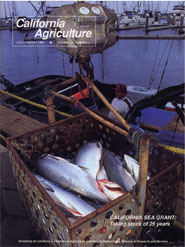All Issues

California Sea Grant: Taking stock of 25 years
Cover:
The California Sea Grant Extension Program, which is about to celebrate its 25th year, develops practical solutions to marine and coastal resource problems such as declining salmon runs. Photo by Jack Kelly Clark
July-August 1997
Volume 51, Number 4
Volume 51, Number 4





